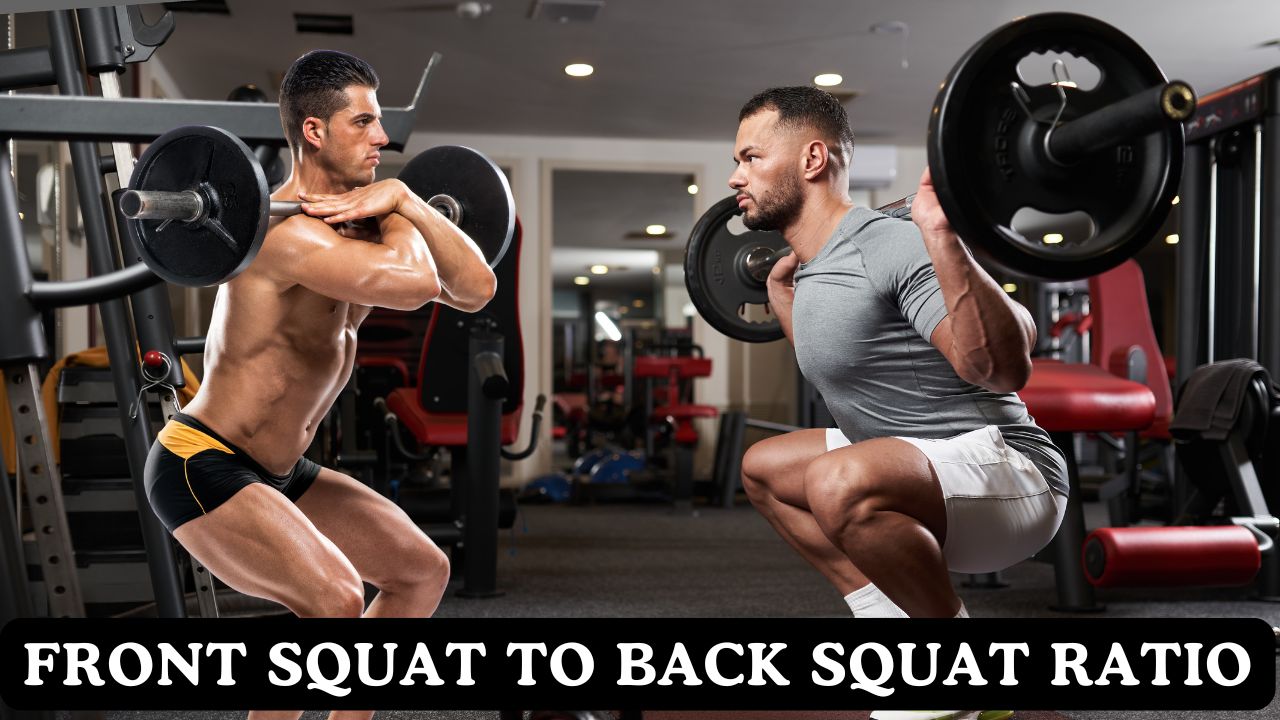Front Squat to Back Squat Ratio Calculator
Calculate precise squat conversions between front and back squat variations based on biomechanical research

Front Squat vs Back Squat
Biomechanical research on squat variations reveals significant differences in muscle activation patterns between front and back squats. EMG analysis shows that front squats produce greater vastus medialis activation during the ascending phase, while back squats demonstrate higher semitendinosus activation and greater trunk lean angles. This differential activation creates the foundation for strength ratio calculations used in our conversion system.
Joint Loading Differences
Comparative biomechanical analysis demonstrates that back squats result in significantly higher compressive forces and knee extensor moments compared to front squats. Front squats show reduced spinal loading while maintaining effective muscle recruitment, making them advantageous for individuals with knee or back concerns. Understanding these differences helps optimize leg strength training programs.
Load-Dependent Mechanical Demands
Recent load-dependent biomechanical research shows that peak hip extensor moments are greater during back squats at 60% and 80% of front squat 1RM, while peak knee extensor moments are greater during front squats at 80% loads. This creates distinct strength ratios between the two movement patterns, which are essential for proper barbell leg workout programming.
Squat Conversion Ratios by Variation & Depth
| From Exercise | To High-Bar | To Low-Bar | To Front Squat | To Overhead |
|---|---|---|---|---|
| High-Bar Back Squat | 1.00 | 0.92 | 0.85 | 0.65 |
| Low-Bar Back Squat | 1.08 | 1.00 | 0.78 | 0.58 |
| Front Squat | 1.18 | 1.28 | 1.00 | 0.72 |
| Overhead Squat | 1.54 | 1.72 | 1.39 | 1.00 |
Ratio Explanation: Conversion ratios based on biomechanical research of trained individuals. Higher ratios indicate greater strength differences between exercises. Low-bar squats typically allow the highest loads due to favorable leverage and posterior chain engagement. For comprehensive squat programming, explore our dumbbell leg exercises guide.
Experience Level Impact on Squat Performance
| Experience Level | Training Duration | Conversion Accuracy | Key Characteristics | Primary Focus |
|---|---|---|---|---|
| Novice | 0-6 months | ±15% | Learning basic movement patterns | Technique development |
| Beginner | 6-18 months | ±12% | Establishing motor patterns | Consistent practice |
| Intermediate | 1.5-3 years | ±8% | Refined movement quality | Load progression |
| Advanced | 3-5 years | ±5% | Consistent technique under load | Specialization |
| Elite | 5+ years | ±3% | Optimal neuromuscular control | Performance optimization |
Neuromuscular Development: Training experience significantly affects conversion accuracy. Advanced lifters demonstrate superior movement quality and can handle loads closer to calculated ratios while maintaining proper form and safety protocols. For beginners, focus on bodyweight leg exercises before progressing to loaded squats.
Scientific Conversion Methodology
Practical Training Applications
Powerlifting & Strength Sports
Powerlifters use front squats as accessory work to improve back squat performance by addressing quadriceps strength and maintaining upright posture. The conversion ratios help determine appropriate loads for accessory training while maintaining specificity to competition movements. Complement your squat training with targeted hamstring exercises for balanced posterior chain development.
Olympic Weightlifting
Weightlifters rely heavily on front squats for clean and jerk performance, while using back squats for maximum strength development. These conversions ensure balanced programming between competition-specific and strength-building movements throughout training cycles. Enhance your Olympic lifting foundation with landmine squat variations for improved stability and movement quality.
Rehabilitation & Injury Prevention
Physical therapists utilize front squats during knee rehabilitation due to reduced compressive forces and extensor moments compared to back squats. The conversion ratios help maintain training intensity while accommodating injury limitations and movement restrictions. Support your rehabilitation with foam rolling exercises for improved mobility and recovery.
Athletic Performance Training
Sport coaches integrate various squat patterns based on movement demands and athlete needs. These conversions ensure appropriate load distribution across squat variations while maintaining progressive overload principles throughout training phases. Enhance athletic performance with cable leg exercises for sport-specific strength development.
Squat Variation Muscle Activation Analysis
| Squat Variation | Quadriceps Activation | Glute Activation | Hamstring Activation | Core Demand | Postural Challenge |
|---|---|---|---|---|---|
| Front Squat | Very High | High | Moderate | Very High | Extreme |
| High-Bar Back Squat | High | High | Moderate | High | Moderate |
| Low-Bar Back Squat | Moderate | Very High | High | High | Low |
| Overhead Squat | High | High | Moderate | Extreme | Extreme |
EMG Research Base: Muscle activation levels based on electromyographic analysis of trained individuals. Higher activation levels typically correlate with greater training stimulus but may limit maximum load capacity. For targeted muscle development, incorporate quad-focused machine exercises and glute-specific movements to complement your squat training.
Mobility Requirements for Squat Variations
Front Squat Mobility Demands
Front squats require exceptional thoracic spine mobility, ankle dorsiflexion, and wrist flexibility for proper front rack position. Limited shoulder or thoracic mobility can compromise form and reduce load capacity. Scapular wall slides and targeted mobility work are essential for front squat progression. The upright torso position demands significant ankle mobility to maintain proper squat mechanics.
Back Squat Mobility Requirements
Back squats require adequate shoulder external rotation, thoracic extension, and hip mobility. Low-bar positioning demands greater shoulder flexibility but allows more forward lean, reducing ankle mobility requirements. High-bar squats require better ankle dorsiflexion but less shoulder mobility. Both variations benefit from comprehensive lower body mobility work including hip flexor and glute stretching protocols.
Overhead Squat Mobility Challenges
Overhead squats present the greatest mobility challenge, requiring full-body flexibility and stability. Key requirements include shoulder flexion, thoracic extension, ankle dorsiflexion, and hip mobility. Any mobility restriction will be magnified in this position, making it an excellent assessment tool for movement quality. Progressive mobility work and lighter loads are essential for safe progression.
Programming Considerations & Periodization
Beginner Programming (0-2 years)
Focus on movement quality and gradual load progression. Start with bodyweight squats and progress to goblet squats before advancing to barbell variations. Emphasize proper depth, knee tracking, and core stability. Use conversion ratios conservatively and prioritize technique over load. Incorporate core strengthening exercises to support squat progression.
Intermediate Programming (2-5 years)
Implement periodized training with varying squat patterns. Use conversion ratios to balance training loads across variations. Incorporate both front and back squats for comprehensive development. Monitor strength ratios and address imbalances through targeted accessory work. Include overhead squat variations for mobility and stability development.
Advanced Programming (5+ years)
Utilize precise conversion ratios for competition preparation and peaking phases. Implement sport-specific squat patterns based on competitive demands. Fine-tune ratios based on individual biomechanics and training response. Use advanced periodization models with varying squat emphasis throughout training cycles. Monitor fatigue and recovery to optimize training adaptations.
Research Limitations & Individual Considerations
While these conversions are based on peer-reviewed biomechanical research, several individual factors may affect accuracy:
- Anthropometric Differences: Limb length ratios, torso length, and hip structure significantly affect squat mechanics and strength ratios.
- Mobility Limitations: Ankle, hip, and thoracic spine mobility restrictions can disproportionately affect certain squat variations.
- Training Specialization: Athletes with extensive experience in one squat variation may show different ratios than balanced practitioners.
- Muscle Fiber Composition: Individual differences in fast-twitch vs. slow-twitch fiber ratios affect strength expression across movement patterns.
- Previous Injury History: Past injuries may create compensation patterns that affect performance in specific squat variations.
- Neuromuscular Coordination: Some individuals naturally excel at certain movement patterns due to superior motor control.
- Equipment Variations: Different barbell types, shoes, and supportive gear can influence loading patterns and performance ratios.
Professional Guidance: These conversions provide scientifically-based starting points for program design. Consult qualified strength coaches or sports scientists for personalized adjustments based on individual biomechanics, training history, and specific goals. Always prioritize movement quality over adherence to calculated loads. For comprehensive fitness assessment, explore our body composition analysis tools and fitness benefits guide.
⚕️ Medical Disclaimer
This Front Squat to Back Squat Ratio calculator provides estimates based on biomechanical research and should not replace professional guidance. Individual strength ratios can vary significantly due to genetics, training history, mobility limitations, and injury history. The calculations are based on population averages and may not accurately reflect individual capabilities or limitations. Always consult with qualified strength coaches, physical therapists, or sports medicine professionals before implementing significant changes to your training program, especially if you have pre-existing injuries or movement limitations. Start with conservative loads and prioritize proper form over calculated weights. This tool is for educational purposes and general guidance only.
References
- Bautista D, Durke D, Cotter JA, Escobar KA, Schick EE. A Comparison of Muscle Activation Among the Front Squat, Overhead Squat, Back Extension and Plank. Int J Exerc Sci. 2020 May 1;13(1):714-722. doi: 10.70252/BTUH3630. PMID: 32509107; PMCID: PMC7241624.
- Gullett, Jonathan C; Tillman, Mark D; Gutierrez, Gregory M; Chow, John W. A Biomechanical Comparison of Back and Front Squats in Healthy Trained Individuals. Journal of Strength and Conditioning Research 23(1):p 284-292, January 2009. | DOI: 10.1519/JSC.0b013e31818546bb
- Straub, R. K., & Powers, C. M. (2024). A Biomechanical Review of the Squat Exercise: Implications for Clinical Practice. International Journal of Sports Physical Therapy, 19(4), 490. https://doi.org/10.26603/001c.94600
- Ciolac, E., Mantuani, S., Neiva, C., Verardi, C., Pessôa-Filho, D., & Pimenta, L. (2015). Rating of perceived exertion as a tool for prescribing and self regulating interval training: A pilot study. Biology of Sport, 32(2), 103.

Manish is a NASM-certified fitness and nutrition coach with over 10 years of experience in weight lifting and fat loss fitness coaching. He specializes in gym-based training and has a lot of knowledge about exercise, lifting technique, biomechanics, and more.
Through “Fit Life Regime,” he generously shares the insights he’s gained over a decade in the field. His goal is to equip others with the knowledge to start their own fitness journey.
